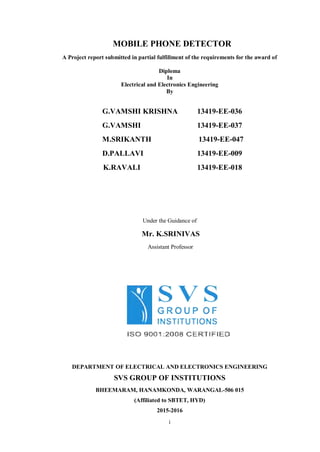This document is a project report submitted by students of the Electrical and Electronics Engineering department at SVS Group of Institutions. The project is about developing a mobile phone detector circuit. The circuit uses components like resistors, capacitors, transistors, LEDs, piezo buzzers, and ICs to detect incoming/outgoing calls, SMS, and video transmissions from an activated mobile phone within 1.5 meters. When a signal is detected, the circuit produces an alarm beep and LED blink until the signal stops. The report describes the circuit diagram and components used. It discusses how the circuit works and potential applications of the mobile phone detector.















![MOBILE PHONE DETECTOR
SVS GROUP OF INSTITUTIONS 9
Extremely long life. Some transistorized devices have been in service for more than
30 years.
Complementary devices available, facilitating the design of complementary-
symmetry circuits, something not possible with vacuum tubes.
Insensitivity to mechanical shock and vibration, thus avoiding the problem of micro
phonics in audio applications.
Limitations
Silicon transistors do not operate at voltages higher than about 1,000 volts (SiC
devices can be operated as high as 3,000 volts). In contrast, electron tubes have been
developed that can be operated at tens of thousands of volts.
High power, high frequency operation, such as used in over-the-air television
broadcasting, is better achieved in electron tubes due to improved electron mobility
in a vacuum.
On average, a higher degree of amplification linearity can be achieved in electron
tubes as compared to equivalent solid state devices, a characteristic that may be
important in high fidelity audio reproduction.
Silicon transistors are much more sensitive than electron tubes to an electromagnetic
pulse, such as generated by an atmospheric nuclear explosion.
Type
Bipolar junction transistor
The bipolar junction transistor (BJT) was the first type of transistor to be mass-
produced. Bipolar transistors are so named because they conduct by using both majority and
minority carriers. The three terminals of the BJT are named emitter, base, and collector. The
BJT consists of two p-n junctions: the base–emitter junction and the base–collector junction,
separated by a thin region of semiconductor known as the base region (two junction diodes
wired together without sharing an intervening semiconducting region will not make a
transistor). "The [BJT] is useful in amplifiers because the currents at the emitter and
collector are controllable by the relatively small base current. In an NPN transistor
operating in the active region, the emitter-base junction is forward biased (electrons and](https://image.slidesharecdn.com/mobilephone-160228112334/85/Mobile-phone-detector-pdf-16-320.jpg)
























